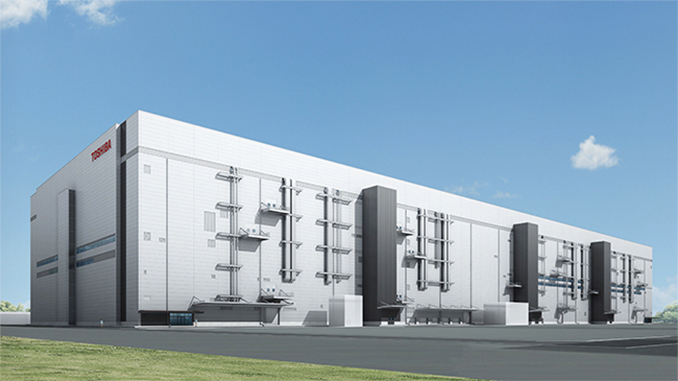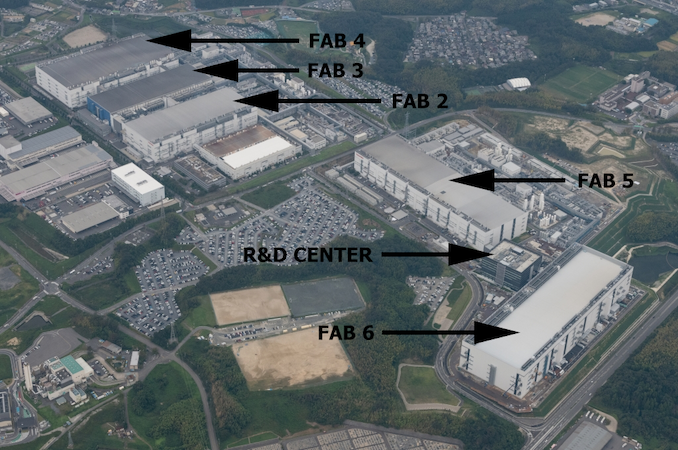Toshiba & WD NAND Production Hit By Power Outage: 6 Exabytes Lost
by Anton Shilov on June 28, 2019 12:15 PM EST
Toshiba Memory and Western Digital on Friday disclosed that an unexpected power outage in the Yokkaichi province in Japan on June 15 affected the manufacturing facilities that are jointly operated. Right now, production facilities are partially halted and they are expected to resume operations only by mid-July.
Western Digital says that the 13-minute power outage impacted wafers that were processed, the facilities, and production equipment. The company indicates that the incident will reduce its NAND flash wafer supply in Q3 by approximately 6 EB (exabytes), which is believed to be about a half of the company’s quarterly supply of NAND. Toshiba does not disclose the impact the outage will have on its NAND wafer supply in the coming months, but confirms that the fabs are partially suspended at the moment. Keeping in mind that Toshiba generally uses more capacity of the fabs than WD, the impact on its supply could be significantly higher than 6 EB with some estimating that it could be as high as ~9 EB.
Both companies are assessing the damage at the moment, so the financial harm of the incident is unclear. Not even counting potential damage to production tools and other equipment used at the fabs, 6 EB of NAND cost a lot of money. Furthermore, analysts from TrendForce believe that a consequence of the outage will be some loss of confidence from clients of both companies, which will have a financial impact as well.
The Yokkaichi Operations campus jointly owned and run by Toshiba and Western Digital produces about 35% of the global NAND output in terms of revenue, according to TrendForce. At present, the manufacturing base has five production facilities (Fab 2, Fab 3, Fab 4, Fab 5, and Fab 6) as well as an R&D center, all of which were affected by the outage. Three fabs within the campus produce 3D NAND flash, whereas another two are used to make special-purpose types of memory.
Considering the gargantuan size of the Yokkaichi Operations, disruptions of its supply will inevitably have an effect on 2D NAND and 3D NAND spot prices in the short-term future. Nonetheless, since contract prices have already been set for Q3 (and possibly Q4), they are not going to change. Meanwhile, it remains to be seen whether large customers will have to go shopping in Q3 or Q4 and affect prices on the spot markets further.
Considering that the Yokkaichi Operations produces at least 1/3 of the global NAND flash output (let’s assume that dollar share more or less corresponds to bit share) and half of its production for the quarter was lost because of the incident, this means that the industry will miss approximately 1/6 (or 16.5%) of the global NAND supply in Q3. Whether or not this will create a deficit on the market that will cause significant price hikes depends on multiple factors and is something that remains to be seen.
Related Reading
- Toshiba Memory and Western Digital Open Fab 6 and New Memory R&D Center
- Toshiba Memory & Western Digital Finalize Fab K1 Investment Agreement
- Toshiba Begins to Construct New BiCS 3D NAND Fab in Iwate Prefecture
- Toshiba Memory to Build New Fab to Produce BiCS 3D NAND
- Toshiba Finalizes Plans for New 3D NAND Fab: Coming Online in 2019
- Toshiba to Build New Fab to Produce BiCS NAND Flash
Sources: Western Digital, Reuters, TrendForce, Blocks & Files












148 Comments
View All Comments
FullmetalTitan - Friday, June 28, 2019 - link
Clearly you have no idea how semiconductor manufacturing works. 13 minutes is an INSANELY long outage. Samsung had at 200ms (yeah, 0.2s) outage in 2017 that cost something like $50M in product losses.Losing power means they lost:
All RF etch tools - any wafers in those tools are scrap
All fab exhaust/pumps/cooling water - any tools with sensitive environments scrap 100%
All power to furnaces - temperature varied from spec, 100% scrap
azfacea - Friday, June 28, 2019 - link
clearly you have no idea how anything works.Eris_Floralia - Saturday, June 29, 2019 - link
Anandtech surely has spanded their reader coverage downwards recently.DyneCorp - Saturday, June 29, 2019 - link
Why don't you elaborate how he's wrong then, smart man?azfacea - Saturday, June 29, 2019 - link
go read the rest of these comments dumb manJedi2155 - Friday, July 5, 2019 - link
The conspiracy theorist in me thinks this is an attempt to artificially raise the market value of NAND.kgardas - Friday, June 28, 2019 - link
What happened? Has SSD price fallen that quickly over past month and so "correction" is needed? Or was there a need to collect some insurance money? 13 minutes outage in *Japan* is from sci-fi category...EliteRetard - Friday, June 28, 2019 - link
Yep, they needed a price correction. Planned out carefully, insurance will pay out fantastically and they'll essentially make a profit on all this (and even more profit on everything else sold for many years after) as prices shoot up. I think this lesson was learned from the HDD flooding a few years back. Obviously that was a real natural accident, this is likely the best possible "accident" they could come up with to simulate the effect (and with very precise control).I'd love to see a documentary on how they did it. It couldn't have been easy to cause such a cascade failure in all the parts of such a complex setup. Wonder how they compensated some engineers from the power company (or the company itself, though that seems more a China thing).
I don't need a tinfoil hat for this one, I stay in Japan 3 months at a time...those people are not hapless idiots.
Diji1 - Tuesday, July 9, 2019 - link
>those people are not hapless idiots.Of course not, not like they'd place diesel backup generators on coast where they know a tsunami will hit one day. Or the nuclear power stations that rely on the diesel generators working to not meltdown.
Nope, that would be the behavior of hapless idiots!
rrinker - Friday, June 28, 2019 - link
After reading the Micro article earlier, when they said production was high and demand low, my cynical side said, wait for the disaster to hit. A few hours later - this article shows up. Let's face it, once or twice is a coincidence, but this sort of thing happens far too often when supply of product X is exceeding demand of product X for it to be always just a coincidence.